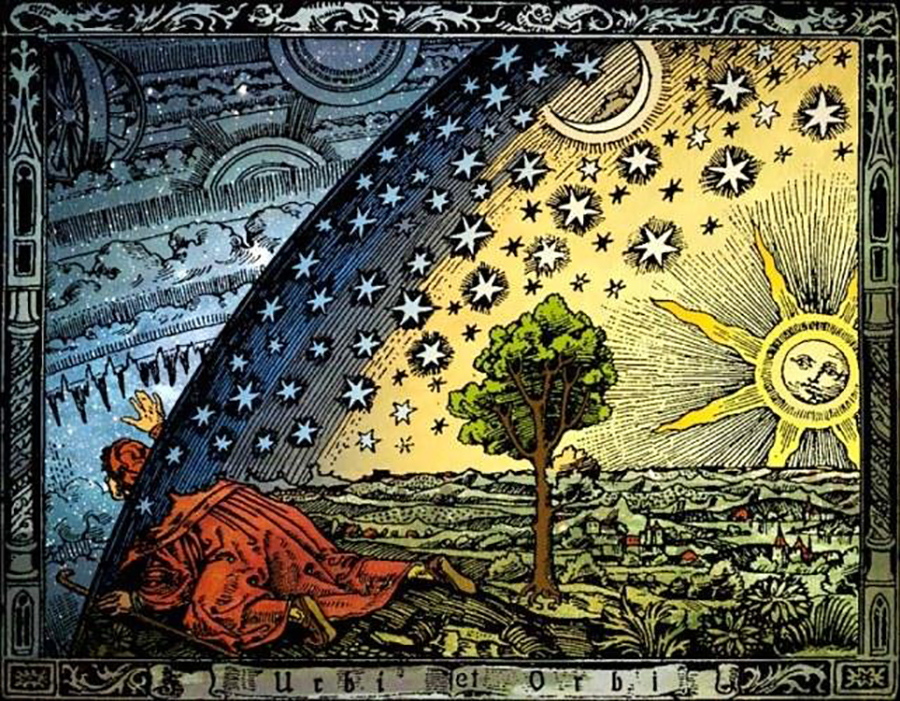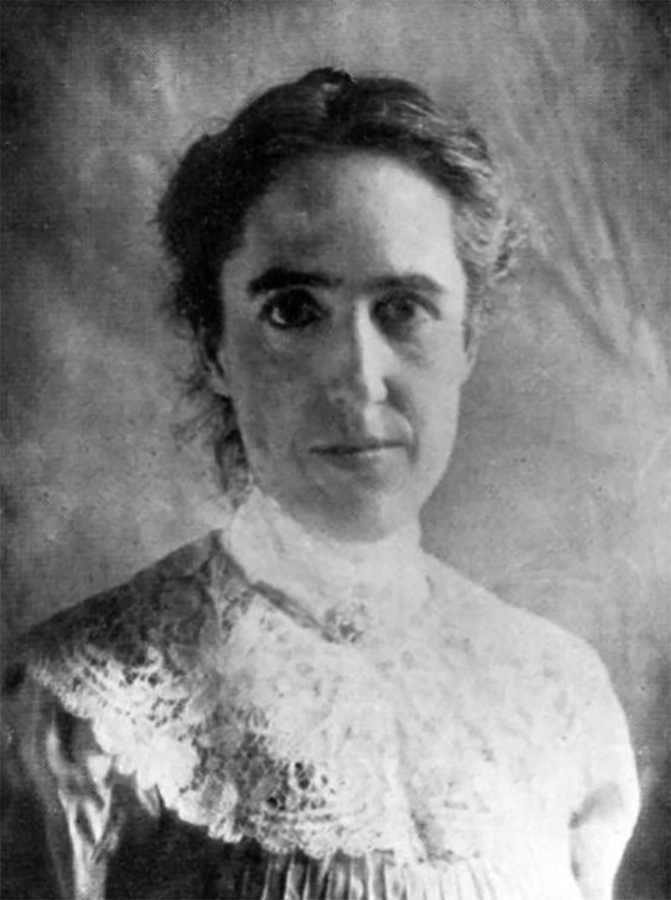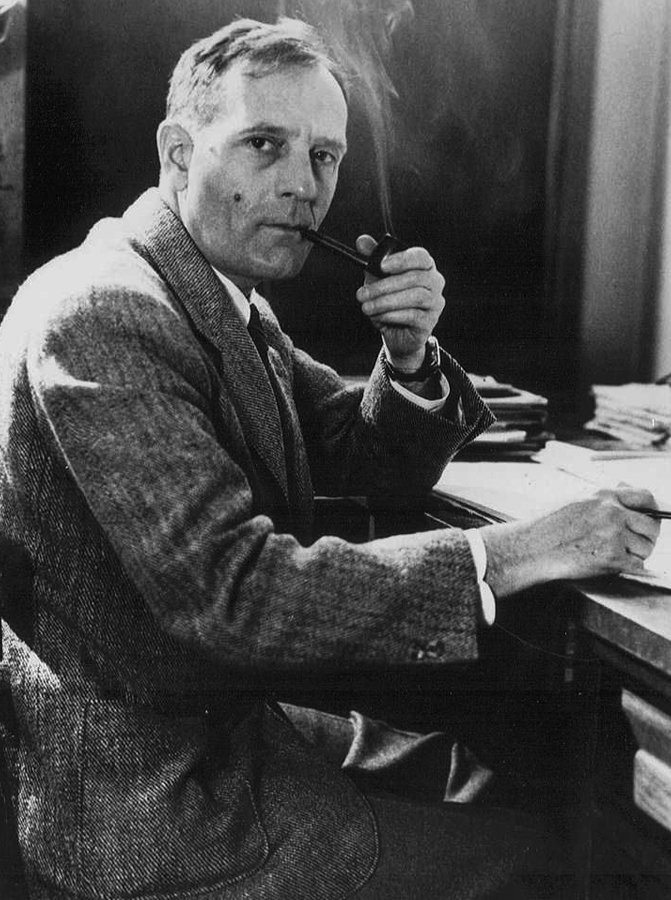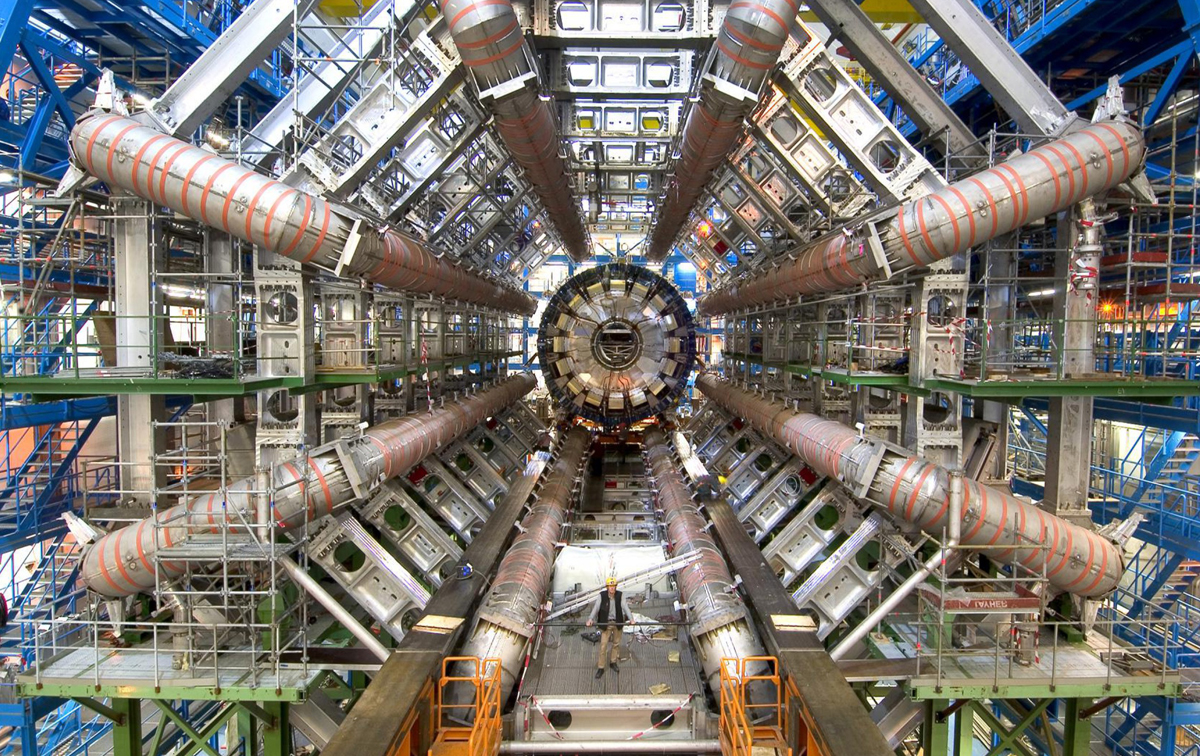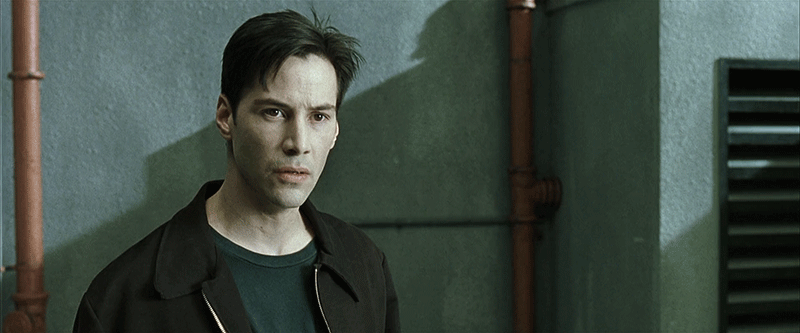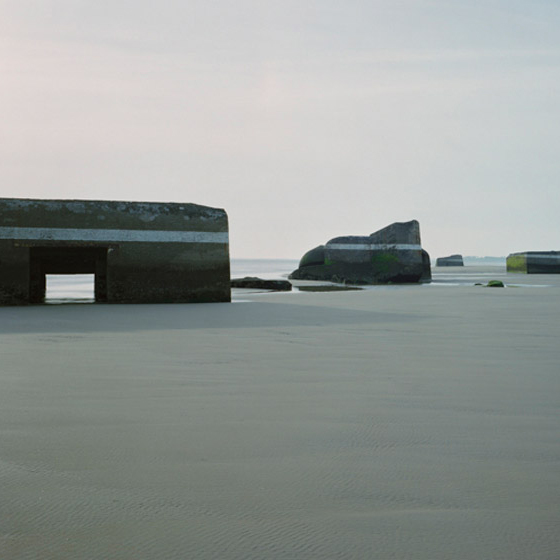THE MULTIVERSE THEORY
BACKSTORY
After attending an inspiring TED talk in August, I became determined to form my own JUNTO with a group of like-minded curious thinkers. What is a JUNTO you ask? Well, you can read my description HERE. So when it came time for the first meeting, I wanted to present a subject that was the modern day equivalent of the earth shaking ideas guys like Benjamin Franklin were talking about in 1727 when the first Junto was formed. After a bit of searching, I settled on The Multiverse Theory. I don’t pretend to have anything more than a layman’s understanding of this stuff, but I present this badly plagiarized summary here for anyone that is interested.
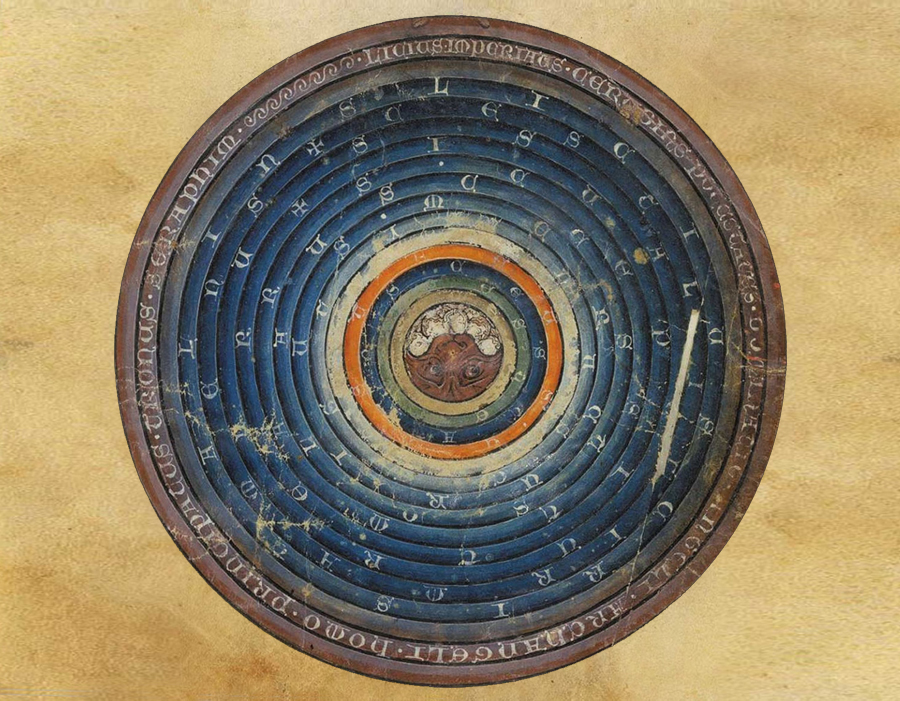
The multiverse theory has been described as:
“as drastic an enlargement of our cosmic perspective as the shift from pre-Copernican ideas to the realization that the Earth is orbiting the sun”
It’s also been called:
“the most dangerous idea in physics”
Indeed, it is perhaps the most radical and earth-shaking scientific notion of our time.
Looking back in history, we can see echoes of the multiverse in different cultures. Parallel worlds with different laws of magic can be found in every major religion. In the Arabian Nights, Lewis Carroll, and H.G. Wells. In Louis Borges, Stan Lee, and countless films.
The word itself first appeared in a journal paper dating from 1895, where William James referred to a “multiverse of experience”.
In 1899, the poet Frederick William Orde Ward gave the term a spiritual aura:
“Within, without, nowhere and everywhere; Now bedrock of the mighty Multiverse, and then the thinnest wreath of thinnest cloud impalpable; the matrix of all things, oceans and airs and the eternities…”
One medieval philosopher in particular came closer than most to describing our current understanding of the cosmos.
Grosseteste had been studying the works of Aristotle, which explained the motion of the stars by embedding Earth in a series of nine concentric celestial spheres.
In De Luce, Grosseteste proposed that the concentric universe began with a flash of light, which pushed everything outwards from a tiny point into a big sphere. Grosseteste assumed that light and matter are coupled together. When the initial pulse of expanding light-matter reached a minimum density, it entered what he called its perfect state, and stopped expanding. This perfect sphere then emitted a different form of light called lumen, which propagated inwards and swept up lingering “imperfect” matter, compressing it like a snow ball. The less dense region of light-matter left behind could then reach its perfect state and crystalize into a new sphere embedded in the first one, which would emit its own lumen. This process continued until only a core of imperfect matter was left behind, the Earth.
Crunching the numbers, the physicists found that computer models of this process yielded exactly the sort of universe Grosseteste was describing: inwardly propagating concentric spheres. Not bad for a 13th century Bishop.
This is analogous to the way modern cosmologists use observations of radiation echoes from the big bang, commonly called the CMB (cosmic microwave background), to test out mathematical models of the modern universe – including a predicted period of rapid expansion called cosmic inflation. By seeding the idea of cosmic inflation, Grosseteste’s universe also predicts one of the most puzzling possibilities of big bang cosmology: the multiverse.
THE EVIDENCE
The first great leap in cosmic inflation was In 1929, when Edwin Hubble produced empirical evidence that the galaxies are moving away from us – expanding in a uniform fashion – as though space itself is expanding like a balloon. He did this through observations of redshift, which occurs when a light source moves away from an observer.
He was building upon the turn of the century discoveries of the American astonomer Henrietta Leavitt, who came up with a method for determining a star’s luminosity, and consequently its distance.
The current idea of the multiverse dates back to the early 1980s, when physicists like MIT’s Alan Guth realized that the current big bang created an equally big problem. When astronomers measured its afterglow, radiation known as the cosmic microwave background (CMB), they found that it was unfathomably uniform – even at opposite ends of the visible universe – it was identical within 1/10,000th of a degree.
How could this be?
According to cosmic inflation, during the first 10 to the minus 34 seconds (0.0000000000000000000000000000000001 seconds), the universe doubled its size at least 90 times. This stupendous stretching, Guth argued, accounts for the uniform temperature of the CMB, and resolves another conundrum: why space appears flat, like an infinite table top.
Inflation, it turns out, has become an incredibly successful theory, precisely predicting the subtle ripples we have since measured in the CMB from way back in time when the galaxies and stars were first seeded.
But inflation didn’t conveniently stop at the farthest regions from which light can travel to us today. Depending on how inflation unfolded, the universe could be 10¹º times, 10²º times, or even infinitely larger than the region we see. Inflation implies an expansion faster than the speed of light, meaning that beyond the horizon of our observable universe lie other parts of the universe that are effectively separated from ours. No influence can travel between these regions, essentially creating an infinite number of other worlds.
Then came the Large Hadron Collider, which as hoped, made the what many would call the most important scientific discovery in the history of mankind: The Higgs Boson particle. The elementary particle that seems a constant throughout the universe. It was predicted nearly 50 years ago, and was found just about exactly where physicists thought it would be. But there was a problem: a host of other particles that they expected to find were nowhere to be seen. The absence of those gave some weight to the notion of “unnaturalness”. Physicists reason that if the universe is unnatural, with extremely unlikely fundamental constants holding it all together and making life as we know it possible, then an enormous number of universes must exist in order for our impossible universe to have been realized.
As it stands in 2014, the theory concludes:
There is not one universe — there is a multiverse.
THE FOUR LEVELS OF MULTIVERSES
MIT’s Max Tegmark defined 4 main types of multiverses that have gained relatively wide acceptance among cosmologists (though there are other, more varied models out there. And for the record, I did NOT make these images below).
LEVEL 1: Beyond our cosmological horizon
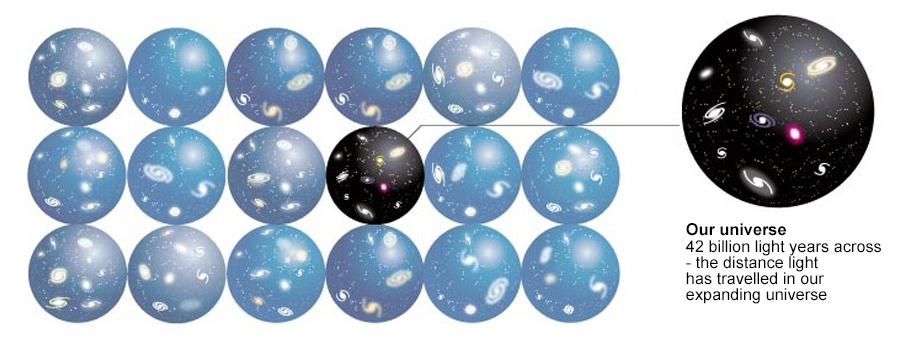
In level 1 of the multiverse theory, not only is our planet one among many, but even our entire universe is just one of countless universes, each doing its own thing. An infinite universe must contain infinite contained universes beyond our sight, because they have expanded beyond the limits of what we can see.
But it gets better: since there’s no indication that space is finite, and particles can only form in so many ways, there’s room for every arrangement that we know of to repeat. Another universe identical to ours. Even another you.
Yet some go further. They suggest completely different kinds of universes, with different physics, different histories, maybe different numbers of spatial dimensions. Most will be sterile. Bust some will be teeming with life. Many may be forming and collapsing all around us as we speak, unable to sustain existence. While some rare universes maybe become stable like ours, and thrive. These begin with Level 2.
LEVEL 2: Universes with different physical constants
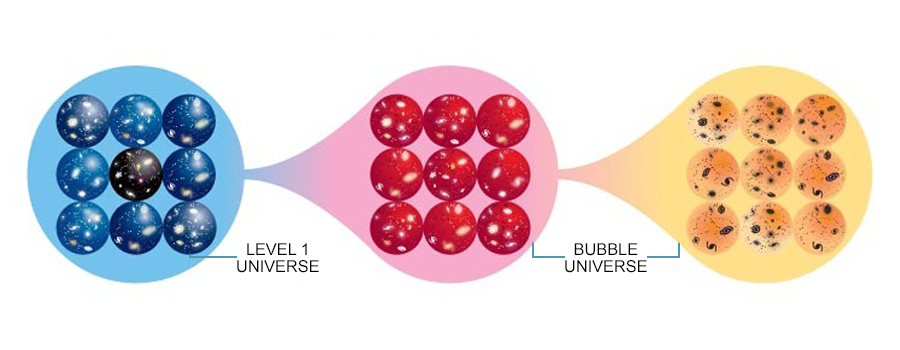
The multiverse as a whole is stretching and will continue doing so forever, but some re- gions of space stop stretching and form distinct bubbles, like gas pockets in a “Swiss cheese” – in which bubbles of normal universe are continually forming out of a surround- ing and exponentially expanding inflationary state. One of those bubbles would be our universe.
LEVEL 3: Many Worlds

The only difference between Level 1 and Level 3 is where your doppelgängers reside. In Level 1 they live elsewhere in good old three-dimensional space. In Level 3 they live on another quantum branch in infinite-dimensional Hilbert space., i.e. higher dimensional space.
LEVEL 4: Ultimate Ensemble
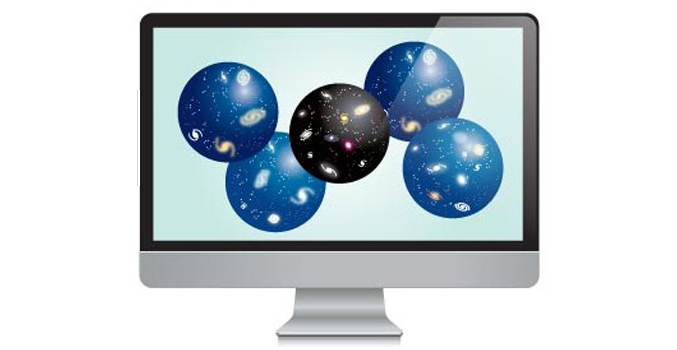
All universes that can be described by different mathematical structures are equally real, and may exist under completely different laws of physics than our own. Essentially: a catch all term for anything goes.
THE IMPLICATIONS
To my mind, one of the more profound effects of this theory is that the multiverse may help explain one of the more vexing paradoxes about our world, sometimes called the “anthropic principle”: the question of whether or not the universe was made for us – one primary urging behind this being the simple fact that we are here observing it.
To cosmologists, our universe looks disturbingly fine-tuned for life. Without its Goldilocks-esque perfect alignment of the physical constants — everything from the strength of the force attaching electrons to atoms to the relative weakness of gravity — planets and suns, biochemistry, and life itself would be impossible.
If ours was the only cosmos spawned by a Big Bang, these life-friendly properties would seem impossibly unlikely. But in a multiverse containing zillions of universes, a small number of life-friendly ones would arise by chance — and we just happen to reside in one of them. That’s why we are seeing what we are seeing. Not because we are special, but because we can.
In short, we got lucky.
In summary, this basic concept of the multiverse, while it likely isn’t the entire story, is just quantum mechanics applied to our best working model of the early universe at this time. When they turn on the Large Hadron Collider again later this year, we will learn more. For the time being, at least, the multiverse is the best cosmology going.
I urge all present among this JUNTO to go forth and preach the good news.

